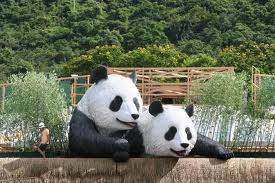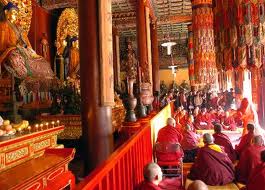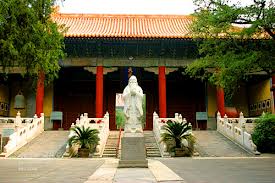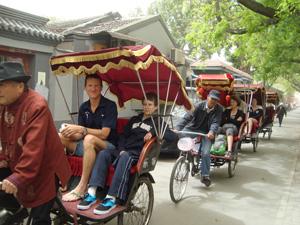Highlights:
• This tour takes you to the best spots of the old imperial center of Beijing. This packed tour will take you to the Beijing Zoo, which houses a great collection of Pandas, the Lhama Temple, the best Buddhist temple in China (besides Tibet), the Confucius Temple, China’s best known temple to the revered sage, a Hutong rickshaw tour which takes you through the heart of Beijing’s folk culture, the Drum Tower, and Nanluoguxiang, a restored Hutong and one of Beijing’s most fashionable spots.
• You will be accompanied on your tour by a professional English-speaking guide, which will make your tour informative, fun, and worry-free!
Detailed itinerary:

1. You will be picked up from your hotel at around 8:30am, and by private van we’ll head to the Beijing Panda House, which is located in the Beijing Zoo. Unlike other zoos in China, the Beijing Zoo has the distinct look of a classical Chinese garden. Initially an imperial manor during the Ming Dynasty, the grounds was converted into a zoo in 1908 with the original name being The Ten Thousand Animal Garden. The Beijing Zoo exhibits the wild and rare animals of China. Outside of traveling to Sichuan, this is the best place in China to view the Giant Panda.
2. After your viewing the Pandas we’ll make the short drive to the Lhama Temple. Other
 than the temples in Tibet this is the best Buddhist temple in China. Work on the Lhama Temple originally began in 1694 during the Qing dynasty. It served as an official residence for court eunuchs. It was then converted into the home of the Prince Yong, a son of the Kangxi Emperor and himself the future Yongzheng Emperor. It was converted into a lamasery after his ascension to the throne in 1722. Today the Lhama Temple still functions as a monastery and temple of the Geluk School of Tibetan Buddhism. Walking through the temple your senses will be enveloped by the incenses and the chanting of the visiting monks and other followers. The rear Pavilion of Ten Thousand Happinesses features a 26m tall statue of the Maitreya Buddha cared from a single piece of white sandalwood. It is one of three artworks in the Lhama Temple that were included in the Guiness Book of World Records, and it is not to be missed on your visit. than the temples in Tibet this is the best Buddhist temple in China. Work on the Lhama Temple originally began in 1694 during the Qing dynasty. It served as an official residence for court eunuchs. It was then converted into the home of the Prince Yong, a son of the Kangxi Emperor and himself the future Yongzheng Emperor. It was converted into a lamasery after his ascension to the throne in 1722. Today the Lhama Temple still functions as a monastery and temple of the Geluk School of Tibetan Buddhism. Walking through the temple your senses will be enveloped by the incenses and the chanting of the visiting monks and other followers. The rear Pavilion of Ten Thousand Happinesses features a 26m tall statue of the Maitreya Buddha cared from a single piece of white sandalwood. It is one of three artworks in the Lhama Temple that were included in the Guiness Book of World Records, and it is not to be missed on your visit.
3. Then it is just a 5 minute walk across the street to the Confucius Temple. The Temple of Confucius was initially built in 1302 and additions were made during the Ming and Qing dynasties. It has a total area of 22,000 square meters (5.4 acres). It is the second largest temple constructed for Confucius, the greatest thinker and educationalist in ancient China, ranking only behind the Temple of Confucius in Qufu, Shandong Province. This temple consists of four courtyards. The main structures include Xianshi Gate (Gate of the First Teacher), Dacheng Gate (Gate of Great Accomplishment), Dacheng Hall (Hall of Great Accomplishment) and Chongshengci (Worship Hall). Dacheng Hall is the main building in the temple, where the memorial ceremony for Confucius was often held. Inside the temple one can see that 198 stone tablets are positioned on either side of the front courtyard, containing 51,624 names of Jinshi (the advanced scholars) of the Yuan, Ming and Qing dynasties. Also 14 stone stele pavilions of the Ming and Qing dynasties hold the precious historical information of ancient China. and additions were made during the Ming and Qing dynasties. It has a total area of 22,000 square meters (5.4 acres). It is the second largest temple constructed for Confucius, the greatest thinker and educationalist in ancient China, ranking only behind the Temple of Confucius in Qufu, Shandong Province. This temple consists of four courtyards. The main structures include Xianshi Gate (Gate of the First Teacher), Dacheng Gate (Gate of Great Accomplishment), Dacheng Hall (Hall of Great Accomplishment) and Chongshengci (Worship Hall). Dacheng Hall is the main building in the temple, where the memorial ceremony for Confucius was often held. Inside the temple one can see that 198 stone tablets are positioned on either side of the front courtyard, containing 51,624 names of Jinshi (the advanced scholars) of the Yuan, Ming and Qing dynasties. Also 14 stone stele pavilions of the Ming and Qing dynasties hold the precious historical information of ancient China.

4. We’ll then take a break for a Chinese lunch, and after lunch you’ll be taken to the Houhai lake area for your Hutong tour. Hutongs are courtyard homes grouped together around narrow alleys, and served as the lifeline and center of everyday life in old Beijing. The hutongs were a critical component in the development and evolution of Beijing folklore and culture. Going on this hutong tour by rickshaw, you will feel like you have traveled back in time to a far different China, one where there was still an emperor sitting in the Forbidden City, and where there was still enough time to enjoy the simple pleasures of common life.
5. Following your Hutong tour we’ll visit the old Drum Tower, which was built in1272 during the reign of Kublai Khan, at which time it stood at the very heart of the Yuan capital Dadu. In ancient times the upper story of the building housed 24 drums, of which only one survives. Its head is made of an entire ox hide and is 1.5 meters in diameter. A sword score on the side of the drum is a souvenir of the Eight-Power Allied Forces' invasion of Beijing in 1900.
 6. From the Drum Tower we’ll walk towards Nanluoguxiang. Nanluoguxiang is one of the best-preserved historical areas of downtown Beijing, as well as being one of the most chic and trendy places to hang out in the afternoons and evenings. The 768-metre-long south-north central lane, with 16 hutong branching off the central lane, is full of interesting craft shops, relaxing cafes and trendy bars. The area has a history of over 700 years and is one of the oldest hutong neighborhoods in the city. 6. From the Drum Tower we’ll walk towards Nanluoguxiang. Nanluoguxiang is one of the best-preserved historical areas of downtown Beijing, as well as being one of the most chic and trendy places to hang out in the afternoons and evenings. The 768-metre-long south-north central lane, with 16 hutong branching off the central lane, is full of interesting craft shops, relaxing cafes and trendy bars. The area has a history of over 700 years and is one of the oldest hutong neighborhoods in the city.
7. After your tour of Nanluoguxiang, you have two choices: you can either be transferred back to your hotel (you’ll be back by 6:00pm) in Beijing or you can continue exploring Naluoguxiang for the rest of the evening.
|



 than the temples in Tibet this is the best Buddhist temple in China. Work on the Lhama Temple originally began in 1694 during the Qing dynasty. It served as an official residence for court eunuchs. It was then converted into the home of the Prince Yong, a son of the Kangxi Emperor and himself the future Yongzheng Emperor. It was converted into a lamasery after his ascension to the throne in 1722. Today the Lhama Temple still functions as a monastery and temple of the Geluk School of Tibetan Buddhism. Walking through the temple your senses will be enveloped by the incenses and the chanting of the visiting monks and other followers. The rear Pavilion of Ten Thousand Happinesses features a 26m tall statue of the Maitreya Buddha cared from a single piece of white sandalwood. It is one of three artworks in the Lhama Temple that were included in the Guiness Book of World Records, and it is not to be missed on your visit.
than the temples in Tibet this is the best Buddhist temple in China. Work on the Lhama Temple originally began in 1694 during the Qing dynasty. It served as an official residence for court eunuchs. It was then converted into the home of the Prince Yong, a son of the Kangxi Emperor and himself the future Yongzheng Emperor. It was converted into a lamasery after his ascension to the throne in 1722. Today the Lhama Temple still functions as a monastery and temple of the Geluk School of Tibetan Buddhism. Walking through the temple your senses will be enveloped by the incenses and the chanting of the visiting monks and other followers. The rear Pavilion of Ten Thousand Happinesses features a 26m tall statue of the Maitreya Buddha cared from a single piece of white sandalwood. It is one of three artworks in the Lhama Temple that were included in the Guiness Book of World Records, and it is not to be missed on your visit. and additions were made during the Ming and Qing dynasties. It has a total area of 22,000 square meters (5.4 acres). It is the second largest temple constructed for Confucius, the greatest thinker and educationalist in ancient China, ranking only behind the Temple of Confucius in Qufu, Shandong Province. This temple consists of four courtyards. The main structures include Xianshi Gate (Gate of the First Teacher), Dacheng Gate (Gate of Great Accomplishment), Dacheng Hall (Hall of Great Accomplishment) and Chongshengci (Worship Hall). Dacheng Hall is the main building in the temple, where the memorial ceremony for Confucius was often held. Inside the temple one can see that 198 stone tablets are positioned on either side of the front courtyard, containing 51,624 names of Jinshi (the advanced scholars) of the Yuan, Ming and Qing dynasties. Also 14 stone stele pavilions of the Ming and Qing dynasties hold the precious historical information of ancient China.
and additions were made during the Ming and Qing dynasties. It has a total area of 22,000 square meters (5.4 acres). It is the second largest temple constructed for Confucius, the greatest thinker and educationalist in ancient China, ranking only behind the Temple of Confucius in Qufu, Shandong Province. This temple consists of four courtyards. The main structures include Xianshi Gate (Gate of the First Teacher), Dacheng Gate (Gate of Great Accomplishment), Dacheng Hall (Hall of Great Accomplishment) and Chongshengci (Worship Hall). Dacheng Hall is the main building in the temple, where the memorial ceremony for Confucius was often held. Inside the temple one can see that 198 stone tablets are positioned on either side of the front courtyard, containing 51,624 names of Jinshi (the advanced scholars) of the Yuan, Ming and Qing dynasties. Also 14 stone stele pavilions of the Ming and Qing dynasties hold the precious historical information of ancient China. 
 6. From the Drum Tower we’ll walk towards Nanluoguxiang. Nanluoguxiang is one of the best-preserved historical areas of downtown Beijing, as well as being one of the most chic and trendy places to hang out in the afternoons and evenings. The 768-metre-long south-north central lane, with 16 hutong branching off the central lane, is full of interesting craft shops, relaxing cafes and trendy bars. The area has a history of over 700 years and is one of the oldest hutong neighborhoods in the city.
6. From the Drum Tower we’ll walk towards Nanluoguxiang. Nanluoguxiang is one of the best-preserved historical areas of downtown Beijing, as well as being one of the most chic and trendy places to hang out in the afternoons and evenings. The 768-metre-long south-north central lane, with 16 hutong branching off the central lane, is full of interesting craft shops, relaxing cafes and trendy bars. The area has a history of over 700 years and is one of the oldest hutong neighborhoods in the city. 
